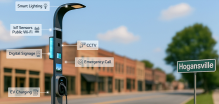"Ericsson is working across the industry to improve the end-user experience and to develop new functionalities and advancements with greater spectral efficiency on LTE," said Fredrik Jejdling, Head of Business Area Networks, Ericsson. "Achieving 1.07Gbps with Verizon and Qualcomm Technologies on a commercial chipset is a big milestone on the road to 5G."
This achievement builds on Ericsson's recent announcement about Gigabit LTE with support for License Assisted Access (LAA). Also of significance, the 1.07Gbps speed was achieved using only three 20MHz carriers of FDD (Frequency Division Duplex using separate transmit and receive frequencies) spectrum, achieving new levels of spectral efficiency for commercial networks and devices. These efficiencies will enable the delivery of the Gigabit class experience to more customers and lead to new wireless innovations, Ericsson said.
The companies achieved the 1.07Gbps industry milestone by using 12 simultaneous LTE streams, which allow for up to 20 percent increase in peak data rates and capacity with a corresponding improvement in average speeds. Ericsson's Radio System and LTE software, in concert with a mobile test device based on the Snapdragon X20 LTE modem, enabled the high speeds.
In the lab, the 1.07Gbps speeds were achieved using all licensed band combinations with:12 LTE streams with 3 cell carrier aggregation of FDD spectrum; 4x4 MIMO per carrier (multiple in, multiple out), which uses multiple antennae at the cell tower and on consumers devices to optimize data speeds; and 256 QAM per carrier, which enables customer devices and the network to exchange information in large amounts, delivering more bits of data in each transmission, significantly enhancing data speeds.
"Qualcomm Technologies has been at the forefront of driving Gigabit LTE in the industry," said Mike Finley, senior vice president and president, Qualcomm North America. "Our work with Verizon and Ericsson has allowed us to be first in surpassing the Gigabit speed barrier with our Snapdragon X20 LTE modem. This is an important milestone on the path to 5G that will allow for better average speeds for all users and will drive new and exciting consumer experiences."


















